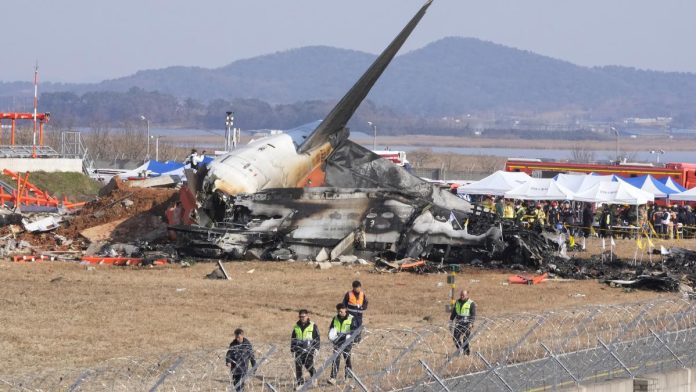A passenger plane in South Korea caught fire on Sunday after skidding off a runway. The crash occurred when the front landing gear reportedly failed to deploy. The collision with a concrete fence killed at least 120 people in one of the country’s worst aviation accidents.
Emergency response and rescue operations
Emergency responders rushed to save passengers on board the Jeju Air flight, which carried 181 people. The crash took place at Muan International Airport, 290 kilometres (180 miles) south of Seoul. The Transport Ministry confirmed the plane was a 15-year-old Boeing 737-800, and the incident occurred at 9:03 a.m.
Authorities have so far confirmed 120 deaths, including 57 women, 54 men, and nine unidentified individuals. Rescuers have not located many passengers, and officials fear the death toll may rise. Two crew members were pulled from the wreckage alive and remain conscious, according to local health officials.
The blaze was contained using over 30 fire trucks and multiple helicopters. News footage showed the plane sliding across the runway without its landing gear deployed. It struck a concrete wall before bursting into flames.
Rescue workers reported that only the aircraft’s tail section was identifiable after the crash. Crews continued searching for remains scattered by the impact.
Investigation underway
Officials are investigating several possible causes for the crash, including mechanical failure and a bird strike. A team from the Transport Ministry arrived at the site to examine the wreckage. Authorities noted that the plane’s landing gear malfunctioned as it arrived from Bangkok.
Two Thai nationals were confirmed among the passengers. Thailand’s Prime Minister, Paetongtarn Shinawatra, expressed condolences and directed officials to assist the victims. Airports of Thailand confirmed that the aircraft left Suvarnabhumi Airport without reported issues.
Jeju Air expressed regret over the crash, promising support for the affected families. President Kim E-bae apologised during a news conference and pledged full cooperation with the investigation. The company stated the plane had passed routine inspections before the flight.
Boeing, the aircraft’s manufacturer, extended condolences and stated its readiness to assist Jeju Air.
Historical context and political complications
The incident ranks among South Korea’s most deadly aviation disasters. In 1997, a Korean Air flight crashed in Guam, killing 228 people. In 2013, an Asiana Airlines flight crash-landed in San Francisco, causing three fatalities and injuring over 200.
Sunday’s crash also recalls major runway disasters, including the 2007 Airbus A320 crash in São Paulo, which claimed 199 lives, and the 2010 Air India Express crash in Mangalore, which killed 158.
The accident occurred during political upheaval in South Korea. President Yoon Suk Yeol’s imposition of martial law led to his impeachment. Deputy Prime Minister Choi Sang-mok, serving as acting president, has directed full deployment of resources for rescue efforts.
